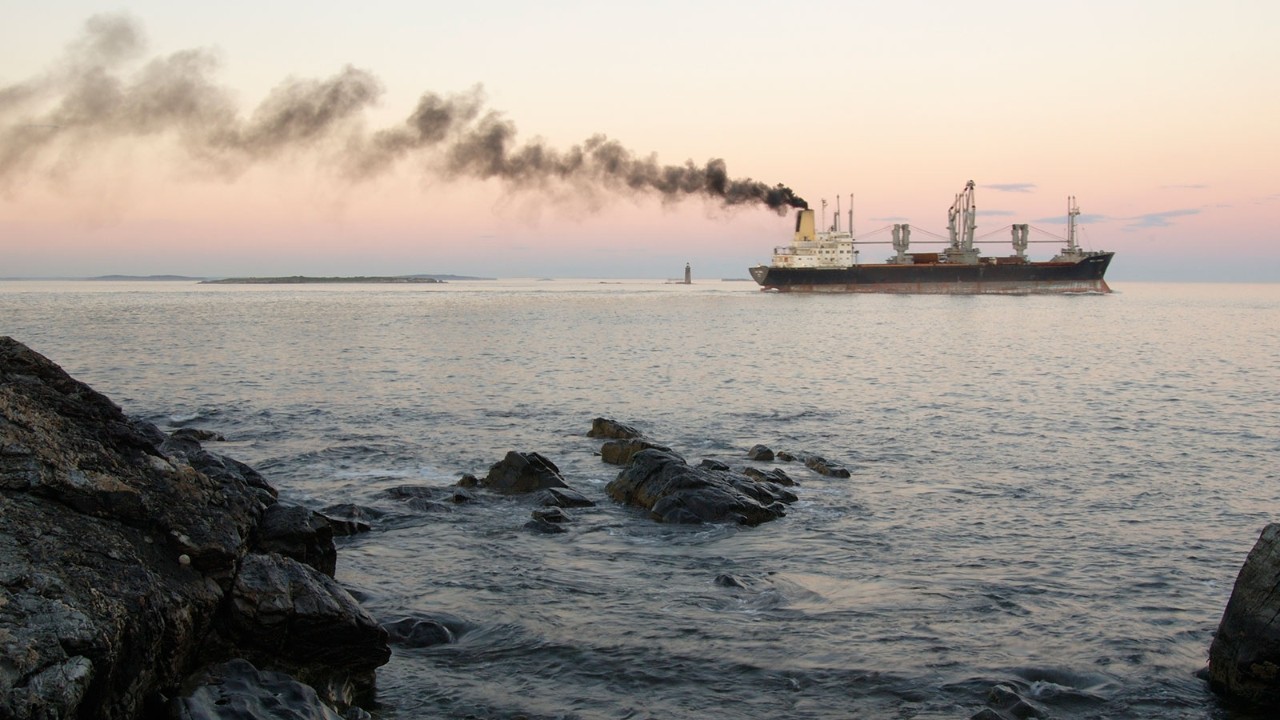
If the global shipping industry were a country, it would rank as the sixth biggest greenhouse gas emitter on the planet. And because the world’s 90,000 or so ocean-going vessels run on some of the dirtiest forms of heavy oil, they don’t just generate 2.5% of heat-trapping carbon dioxide globally, they also emit substantial volumes of toxic air pollutants in the form of black carbon and nitrogen oxides.
Yet the industry’s ecological impact has rarely featured in most discussions of climate change. Whereas petrol is taxed in most countries, marine fuel isn’t, and the sector’s emissions are lightly regulated.
‘The ships we are building now will still be sailing in 2050, so we don’t have much time to lose in shifting to cleaner technologies’
Jacob Armstrong, policy officer at the European non-profit Transport & Environment, says: ‘Since the industry’s activity mostly takes place far out to sea, and so is not visible to most people, shipping has not been subject to the same sustainability pressures as many other businesses.’
Until now, that is.
EU gets tough
The European Union (EU) has launched a determined campaign to move the industry toward more sustainable practices. In July, it announced plans to add shipping to its emissions trading system (ETS), which currently applies only to power plants and factories – making ship owners pay for pollution from their vessels or face bans from EU ports. Under the proposals, ship owners will need ETS permits to cover 20% of their emissions from 2023, rising annually to 100% in 2026. Ships would also be required to burn less greenhouse gas-intensive fuels.
The EU move follows dissatisfaction at the level of targets set by the shipping regulator the International Maritime Organization (IMO) in 2018, which aim only to reduce the industry’s carbon emissions to half its 2008 levels by 2050. By contrast, the EU, along with the US and the UK, has embraced the goal of zero net emissions by 2050.
‘We simply can’t wait for the IMO,’ says Jutta Paulus, a member of the European parliament. ‘All sectors must be included in the effort to lower emissions, including shipping.’
Separately, some major nations, including the US, Norway and Denmark, have also called for faster action on lowering greenhouse gas levels, as part of the Zero-Emission Shipping Mission, by scaling up and deploying new green maritime solutions and setting international shipping on an zero-emission course. France, Ghana, India, Singapore, South Korea and the UK also support the initiative, and some Pacific nations threatened by rising sea levels, such as the Marshall Islands (an important flag state for shipping), are joining in.
Finally, several major shipping companies have also accepted that the industry needs a more rapid transition. ‘The ships we are building now will still be sailing in 2050, so we don’t have much time to lose in making the shift to cleaner technologies,’ says Roy Campe, chief technology officer at Compagnie Maritime Belge, which has around 140 seagoing vessels.
Transition troubles
The sovereign state winds may be starting to blow powerfully in favour of environmental considerations, but curbing emissions from the industry poses political and technological challenges.
On the political side, it remains unclear who should be held responsible for emissions at the country level. ‘It is not uncommon for the owner of a ship to be from one state, the company that charters [leases] the ship to be from another, while the flag it flies is from another state, and its home port yet another,’ Armstrong says. ‘The industry could be accused of playing on this complexity to stall regulation.’
The EU proposals seek to cut through much of this complexity by making the nation the ship sails to responsible for half of the emissions. ‘This makes a lot of sense since the destination nation of a ship is benefitting from international trade,’ Armstrong says.
Economic impact
But could stricter emission controls cripple the economies of the flag states that account for much of the world’s shipping – Panama, Liberia, the Marshall Islands, Singapore and Malta – which attract ship owners through a combination of lighter regulation, less red tape and lower costs?
‘These nations have historically been among the major opponents of ecological regulation at the IMO, mainly because they have been eager to oblige an industry that is important to their economies,’ says Armstrong. ‘However, even if such rules came into force globally, these small nations would still offer sufficiently attractive regulations that ship owners would still want to register there. The economic impact on them could therefore be quite muted.’
Indeed, the economic opportunities arising from a green transition in shipping could be significant, according to Edoardo Casarotto, a maritime and shipping consultant at the World Bank. ‘Decarbonisation would require more than US$1 trillion of investment in terms of developing new technology, energy sources and infrastructure,’ he says. Meanwhile, Transport & Environment believes that the shift to green shipping could generate up to two million jobs globally.
Beyond hydrocarbon
The technological challenges meanwhile are sizeable, but surely solvable. Part of the solution could be to harness the original maritime fuel – the wind. ‘Even by retrofitting various forms of wind propulsion technology to existing ships you could cut fuel requirements by around 20%,’ says Gavin Allwright, secretary of the International Windship Association. ‘With specially designed vessels you can achieve much greater energy savings of above 50% on certain routes. And this source is free, abundant, and requires no additional infrastructure at ports or supply chain to deliver energy.’
‘Decarbonisation will require more than US$1 trillion of investment in developing new technology, energy sources and infrastructure’
In terms of power, by far the most promising technologies to smooth the transition to zero carbon energy sources are liquefied ammonia and hydrogen. While both have drawbacks, including toxicity and combustibility, they are zero-emission fuels that parts of the industry are confident can be used safely in an industrial context. Both are still largely produced with fossil fuels, but can be made with water and renewable energy using electrolysis. ‘From a ship owner’s point of view, hydrogen technology is ready,’ says Campe. ‘However, ammonia is regarded as the main clean fuel for the future for ocean-going vessels.’
Campe points out that some of the big beneficiaries of such a change could be African nations. The continent’s potential for solar energy makes it a convenient place to produce both green hydrogen and ammonia. Compagnie Maritime Belge, for example, is currently developing a €2bn (US$2.38bn) green ammonia plant in Namibia.
The way ahead
As with altering the course of a supertanker, the changes that must happen if emissions from the maritime industry are to be reduced will take time – which is fast running out for the planet. However, with determination and cooperation between stakeholders they can be achieved.
‘It will take effort and determination to become greener,’ admits Allwright. ‘However, we have a robust toolbox of solutions and the industry has recently taken some crucial steps. A course correction is under way.’
Shipping stats
- Over 90% of world trade is carried across the world’s oceans by some 90,000 marine vessels, according to environmental non-profit Oceana.
- The US, China, Russia, India and Japan are the only nation states that emit more carbon dioxide than the world’s shipping fleet.
- Proposed measures to cut fuel consumption (and therefore lower greenhouse gas emissions) include speed reductions, weather routeing (which can cut fuel consumption by at least 3%, and up to 10% for container ships, according to the IMO), fuel switching, specialised anti-fouling hull coatings, and new energy sources.
- An International Council on Clean Transportation report revealed that ocean-going vessels released 812 million metric tons of carbon dioxide in 2015, and that 55% of all shipping emissions come from container ships (23%), bulk carriers (19%) and oil tankers (13%).
- Global freight demand is expected to triple by 2050, according to projections by intergovernmental think-tank the International Transport Forum.
More information
For information on how accountants can create sustainable value for organisations, visit ACCA’s sustainability reporting hub




